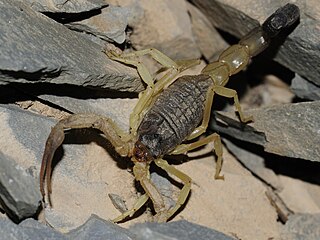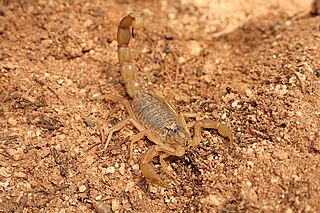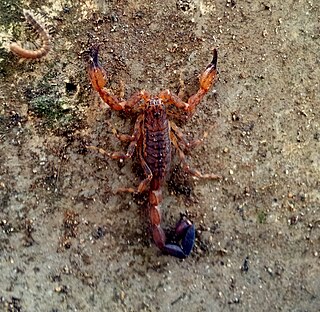
Scorpions are predatory arachnids of the order Scorpiones. They have eight legs, and are easily recognized by a pair of grasping pincers and a narrow, segmented tail, often carried in a characteristic forward curve over the back and always ending with a stinger. The evolutionary history of scorpions goes back 435 million years. They mainly live in deserts but have adapted to a wide range of environmental conditions, and can be found on all continents except Antarctica. There are over 2,500 described species, with 22 extant (living) families recognized to date. Their taxonomy is being revised to account for 21st-century genomic studies.

The striped bark scorpion is an extremely common scorpion found throughout the midsection of the United States and northern Mexico. It is perhaps the most frequently encountered scorpion in the U.S.

The Buthidae are the largest family of scorpions, containing about 100 genera and 1339 species as of 2022. A few very large genera are known, but a high number of species-poor or monotypic ones also exist. New taxa are being described at a rate of several new species per year. They have a cosmopolitan distribution throughout tropical and subtropical environments worldwide. Together with four other families, the Buthidae make up the superfamily Buthoidea. The family was established by Carl Ludwig Koch in 1837.

Centruroides is a genus of scorpions of the family Buthidae. Several North American species are known by the common vernacular name bark scorpion. Numerous species are extensively found throughout the southern United States, Mexico, Central America, the Antilles and northern South America. Some are known for their interesting patterning or large size ; most if not all fluoresce strongly under ultraviolet illumination, except after moulting. They contain several highly venomous species, and fatalities are known to occur. The venom of the Mexican scorpion Centruroides limpidus limpidus contains the neurotoxins Cll1 and Cll2.

Hottentotta is a genus of scorpions of the family Buthidae. It is distributed widely across Africa, except for most of the Sahara desert. Species in the genus also occur in the Middle East, the Arabian Peninsula, southeastern Turkey, Iraq, Iran, Afghanistan, Pakistan, India, Nepal, Cape Verde Islands, and Sri Lanka (introduced).

Leiurus is a genus of scorpion of the family Buthidae. The most common species, L. quinquestriatus, is also known under the common name Deathstalker. It is distributed widely across North Africa and the Middle East, including the western and southern Arabian Peninsula and southeastern Turkey. At least one species occurs in West Africa.

Buthus is a genus of scorpion belonging and being eponymous to the family Buthidae. It is distributed widely across northern Africa, including Morocco, Mauritania, Algeria, Tunisia, Libya, Egypt, Senegal, Guinea-Bissau, Nigeria, Sudan, Somalia, Ethiopia, Djibouti, as well as the Middle East, including Israel, Palestine, Jordan, Lebanon, Iraq, Yemen, and possibly Saudi Arabia and southern Turkey. Its European range includes the Iberian Peninsula, southern France, and Cyprus.

Centruroides gracilis is a species of scorpion in the family Buthidae, the bark scorpions. Its common names include Florida bark scorpion, brown bark scorpion, and slender brown scorpion. In Cuba it is known as alacran prieto and alacran azul. Contrary to one of its common names, it is not actually native to Florida in the United States. It is native to northern parts of the middle Americas, including Mexico, Guatemala, Belize, and Honduras. It is present in other parts as an introduced species, including Cuba, Panama, Colombia, Ecuador, Jamaica, and Florida in the United States. It is also introduced in parts of Africa, including Cameroon and Gabon, as well as the Canary Islands.

Reddyanus besucheti is a species of scorpion in the family Buthidae endemic to Sri Lanka.
Centruroides underwoodi is a species of scorpion in the family Buthidae.
Centruroides flavopictus is a species of scorpion in the family Buthidae. It is native to Mexico.
Centruroides fulvipes is a species of scorpion in the family Buthidae. It is native to Mexico.
Centruroides nigrescens is a species of scorpion in the family Buthidae. It is native to Mexico.
Centruroides nigrimanus is a species of scorpion in the family Buthidae. This species is endemic of Mexico. It occurs in the Mexican states of Chiapas, Oaxaca and Guerrero. [Pocock 1998 indicated a juvenile specimen from Honduras might be this species, but this has never been substantiated, and unlikely]
Centruroides nigrovariatus is a species of scorpion in the family Buthidae. It is native to Mexico.

Centruroides ochraceus is a species of scorpion in the family Buthidae. It is native to Mexico.
Centruroides pallidiceps is a species of scorpion in the family Buthidae. It is native to Mexico.
Centruroides baergi is a species of scorpion in the family Buthidae. They are commonly found in highlands and are almost exclusively found in the states of Oaxaca and southern Puebla, Mexico. C. baergi is the most abundant scorpion of the genus in the state of Oaxaca, making up a third of Centruroides reported between 2008 and 2014.
Centruroides chamulaensis is a species of scorpion in the family Buthidae. It is native to Mexico.
Centruroides chiapanensis is a species of scorpion in the family Buthidae. It is native to Mexico.








